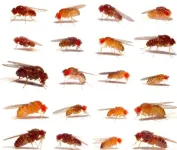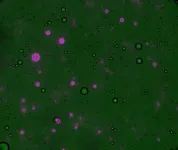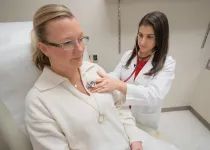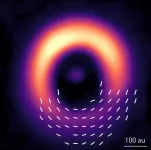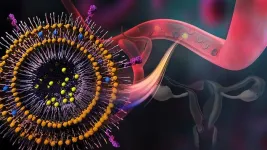(Press-News.org) Finding life in outer space is one of the great endeavors of humankind. One approach is to find motile microorganisms that can move independently, an ability that is a solid hint for life. If movement is induced by a chemical and an organism moves in response, it is known as chemotaxis.
Now, researchers in Germany have developed a new and simplified method for inducing chemotactic motility in some of Earth’s smallest life forms. They published their results in Frontiers in Astronomy and Space Sciences.
“We tested three types of microbes – two bacteria and one type of archaea – and found that they all moved toward a chemical called L-serine,” said Max Riekeles, a researcher at the Technical University of Berlin. “This movement, known as chemotaxis, could be a strong indicator of life and could guide future space missions looking for living organisms on Mars or other planets.”
Extreme survivors
The species included in the study were chosen due to their ability to survive in extreme environments. The highly motile Bacillus subtilis, in its spore form, can survive extreme conditions and endure temperatures of up to 100°C. Pseudoalteromonas haloplanktis, which is isolated from Antarctic waters, has an aptitude for growing in colder environments, between -2.5° and 29°C. The archaeon Haloferax volcanii (H. volcanii), belongs to a group similar to bacteria but is genetically different. Its natural habitats include the Dead Sea and other highly saline environments, so it, too, is well adapted to tolerate extreme conditions.
“Bacteria and archaea are two of the oldest forms of life on Earth, but they move in different ways and evolved motility systems independently from each other,” Riekeles explained. “By testing both groups, we can make life detection methods more reliable for space missions.”
L-serine, the amino acid the researchers used to get these species moving, has previously been shown to trigger chemotaxis in a wide range of species from all domains of life. It is also believed to exist on Mars. If life on Mars has a similar biochemistry to life on Earth, it is plausible that L-serine could attract potential Martian microbes.
Moving microbes
The results showed that L-serine worked as an attractor for all three species. “Especially the usage of H. volcanii broadens the scope of potential life forms that can be detected using chemotaxis-based methodologies, even when it is known that some archaea possess chemotactic systems,” Riekeles explained. “Since H. volcanii is thriving in extreme salty environments, it could be a good model for the kinds of life we might find on Mars.”
The researchers used a simplified approach, which might make the difference between it being feasible on future space missions or not. Instead of complex equipment, they used a slide with two chambers separated by a thin membrane. Microbes are placed on one side, and the chemical L-serine is added to the other. “If the microbes are alive and able to move, they swim toward the L-serine through the membrane,” Riekeles explained. “This method is easy, affordable, and doesn’t require powerful computers to analyze the results.”
For this method to work on a space mission, however, some adjustments to the process would be needed, the researchers said. Smaller and more robust equipment that can survive the harsh conditions of space travel and a system that can work automatically without human intervention are two of them.
Once these difficulties are overcome, microbial movement could help detect microbes that might exist in outer space, for example, in the ocean of Jupiter’s moon Europa. “This approach could make life detection cheaper and faster, helping future missions achieve more with fewer resources,” concluded Riekeles. “It could be a simple way to look for life on future Mars missions and a useful addition for direct motility observation techniques.”
END
Efforts to find alien life could be boosted by simple test that gets microbes moving
Scientists explored microbial movement as a possible biosignature to detect life on Mars and beyond, cheaper and faster than ever before
2025-02-06
ELSE PRESS RELEASES FROM THIS DATE:
Study shows some species are susceptible to broad range of viruses
2025-02-06
A study of fruit flies shows some species are highly susceptible to a wide range of viruses.
In the study – by the University of Exeter – 35 fruit fly species were exposed to 11 different viruses of diverse types.
As expected, fly species that were less affected by a certain virus also tended to respond well to related viruses.
But the findings also show “positive correlations in susceptibility” to viruses in general. In other words, fly species that were resistant to one virus were generally resistant to others – including very different ...
How life's building blocks took shape on early Earth: the limits of membraneless polyester protocell formation
2025-02-06
One leading theory on the origins of life on Earth proposes that simple chemical molecules gradually became more complex, ultimately forming protocells—primitive, non-living structures that were precursors of modern cells. A promising candidate for protocells is polyester microdroplets, which form through the simple polymerisation of alpha-hydroxy acids (αHAs), compounds believed to have accumulated on early Earth possibly formed by lightning strikes or delivered via meteorites, into protocells, followed by simple rehydration ...
Survey: Many Americans don’t know long-term risks of heart disease with pregnancy
2025-02-06
COLUMBUS, Ohio – Pregnancy-related deaths in the U.S. have risen 140% over the past three decades with heart disease a major cause, according to the American Heart Association. A new national survey commissioned by The Ohio State University Wexner Medical Center found that many Americans are not aware of the long-term risks of heart disease with pregnancy and the critical care needed before, during and after pregnancy.
“During pregnancy there are a lot of different hormone shifts that happen to accommodate growth of the baby and health of the mom. The result is that the mom’s heart rate increases along with the amount ...
Dusting for stars’ magnetic fingerprints
2025-02-06
For the first time astronomers have succeeded in observing the magnetic field around a young star where planets are thought to be forming. The team was able to use dust to measure the three-dimensional structure “fingerprint” of the magnetic field. This will help improve our understanding of planet formation.
Planets form in turbulent disks of gas and dust called protoplanetary disks around young stars. It is thought that the first step in planet formation is dust grains colliding and sticking together. The movement of ...
Relief could be on the way for UTI sufferers dealing with debilitating pain
2025-02-06
Relief could be on the way for UTI sufferers dealing with debilitating pain
New insights into what causes the painful and disruptive symptoms of urinary tract infections (UTIs) could offer hope for improved treatment.
UTIs are one of the most prevalent bacterial infections globally, with more than 400 million cases reported every year. Nearly one in three women will experience UTIs before the age of 24, and many elderly people and those with bladder issues from spinal cord injuries can experience multiple UTI’s in a single year.
Findings from a new study led by Flinders University’s ...
Testing AI with AI: Ensuring effective AI implementation in clinical practice
2025-02-06
Using a pioneering artificial intelligence platform, Flinders University researchers have assessed whether a cardiac AI tool recently trialled in South Australian hospitals actually has the potential to assist doctors and nurses to rapidly diagnose heart issues in emergency departments.
“AI is becoming more common in healthcare, but it doesn’t always fit in smoothly with the vital work of our doctors and nurses,” says Flinders University’s Dr Maria Alejandra Pinero de Plaza, who led the research.
“We need to confirm these systems are trustworthy and work ...
Researchers find improved method for treating rare, aggressive, pregnancy-related cancer
2025-02-06
PORTLAND, Ore. – A new drug delivery system shows promise for treating a rare, aggressive form of cancer affecting pregnant women and new mothers, and it has potential with other cancers as well.
Scientists led by Olena Taratula, a nanomedicine researcher at Oregon State University, have found a way to better ensure the drug used to combat the disease reaches tumor cells without damaging healthy tissue.
Findings of the study into choriocarcinoma, which occurs in the United States at a rate of about four cases per 100,000 pregnancies, ...
Half of the fish you eat comes from the Great Barrier Reef’s marine reserves
2025-02-06
A new study of the Great Barrier Reef has revealed that the network of no-take marine reserves supplies nearly half of the region’s coral trout fishery catch.
The research, led by Professor Michael Bode from the QUT School of Mathematical Sciences and published in Science Advances, revealed that despite covering only 30 per cent of the reef’s habitat, these protected areas account for 47 per cent of the coral trout catch in fishing areas and contribute 55 per cent of the species’ reproduction.
The Great Barrier Reef is protected by a network of marine reserves designed to conserve ...
McDonald’s thwarts council efforts to stop new branches by claiming it promotes ‘healthier lifestyles’
2025-02-06
McDonald's is overturning council attempts to prevent new fast food outlets by claiming they will encourage healthier lifestyles, reveals an investigation published by The BMJ today.
Based on Freedom of Information requests, it shows that the firm has won planning appeals against local authorities in some of the most deprived areas of England, where around 1 in 4 children are obese by the time they leave primary school.
Its tactics include arguing that customers can order salad from its drive-through branches, that they could cycle or walk there, and that its sponsorship ...
Is CBD use during pregnancy as safe as people think? New study uncovers potential risks to babies
2025-02-06
Cannabidiol (CBD), the component in cannabis often used for therapeutic treatments, is increasingly being used during pregnancy as a means of managing symptoms such as nausea, anxiety and sleep. Though the public perception is that CBD – particularly when consumed orally – is safer and helpful for symptom management, little is known about the impact of CBD on pregnancy.
A new study from McMaster University researchers fills that gap in knowledge and has uncovered potential risks, including impaired fetal growth, associated with the use of both tetrahydrocannabinol (THC), the ...
LAST 30 PRESS RELEASES:
University of Oklahoma researcher awarded funding to pursue AI-powered material design
Exploring how the visual system recovers following injury
Support for parents with infants at pediatric check-ups leads to better reading and math skills in elementary school
Kids’ behavioral health is a growing share of family health costs
Day & night: Cancer disrupts the brain’s natural rhythm
COVID-19 vaccination significantly reduces risk to pregnant women and baby
The role of vaccination in maternal and perinatal outcomes associated with COVID-19 in pregnancy
Mayo Clinic smartwatch system helps parents shorten and defuse children's severe tantrums early
Behavioral health spending spikes to 40% of all children’s health expenditures, nearly doubling in a decade
Digital cognitive behavioral treatment for generalized anxiety disorder
Expenditures for pediatric behavioral health care over time and estimated family financial burden
Air conditioning in nursing homes and mortality during extreme heat
The Alps to lose a record number of glaciers in the next decade
What makes a good proton conductor?
New science reporting guide published for journalists in Bulgaria
New international study reveals major survival gaps among children with cancer
New science reporting guide published for journalists in Turkey
Scientists develop a smarter mRNA therapy that knows which cells to target
Neuroanatomy-informed brain–machine hybrid intelligence for robust acoustic target detection
Eight SwRI hydrogen projects funded by ENERGYWERX
The Lundquist Institute and its start-up company Vitalex Biosciences Announces Strategic Advancement of Second-Generation fungal Vaccine VXV-01 through Phase 1 Trials under $40 Million Competitive Con
Fine particles in pollution are associated with early signs of autoimmune disease
Review article | Towards a Global Ground-Based Earth Observatory (GGBEO): Leveraging existing systems and networks
Penn and UMich create world’s smallest programmable, autonomous robots
Cleveland researchers launch first major study to address ‘hidden performance killer’ in athletes
To connect across politics, try saying what you oppose
Modulating key interaction prevents virus from entering cells
Project explores barriers to NHS career progression facing international medical graduates
Jeonbuk National University researchers explore the impact of different seasonings on the flavor perception of Doenjang soup
Two Keck Medicine of USC Hospitals named Leapfrog Top Teaching Hospitals
[Press-News.org] Efforts to find alien life could be boosted by simple test that gets microbes movingScientists explored microbial movement as a possible biosignature to detect life on Mars and beyond, cheaper and faster than ever before
